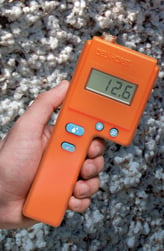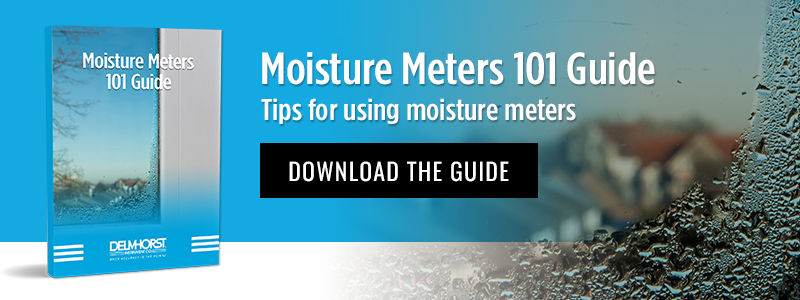 Cotton has long been one of the most important crops grown in the U.S. Across the world, textile producers rely heavily on cotton for making their products. Because of the near-constant demand for cotton, it has long been a cornerstone of American farming.
Cotton has long been one of the most important crops grown in the U.S. Across the world, textile producers rely heavily on cotton for making their products. Because of the near-constant demand for cotton, it has long been a cornerstone of American farming.
However, farmers face many challenges in growing cotton. Invasive pests such as the infamous boll weevil can quickly destroy a cotton field, and properly processing cotton takes a lot of specialized equipment to remove seed from cotton.
Cotton and Moisture Testing
Another challenge that farmers are all too familiar with that the average layman might not know about is the need to closely monitor the moisture content of cotton during the harvest.
For example, cotton that is too wet can stick to machinery, causing it to jam, and possibly damaging the equipment. On the other hand, dry cotton fibers can get damaged during the harvest, which can ruin the usefulness of the cotton as a textile fiber.
This is why it’s important to check the moisture content of cotton prior to harvesting it.
Unfortunately, a simple hand test won’t give give you a reliable, quantifiable assessment of the moisture content of cotton. This prevents you from getting the information you need to make the best decision for controlling moisture in your cotton crop.
Oven dry tests, on the other hand, are accurate, but can take far too long to complete. By the time an oven dry test is finished, there could be a large change in the moisture content of the rest of your cotton. Plus, oven dry tests can be destructive to the cotton being tested.
This is where cotton moisture meters come into play. These devices can provide a fast, quantifiable measurement of the moisture content of your cotton. This allows you to get the info you need to make an informed decision about your cotton quickly.
These devices can be incredibly useful for cotton farmers in helping to monitor and control cotton moisture. You might be wondering “how is it that these devices can provide reliable, quantifiable data about the moisture content of cotton?”
Here’s how:
How Cotton Moisture Meters Work
If you’ve read some of our other blogs, then you might be familiar with the operation of different types of moisture meters. Cotton moisture meters work in a manner similar to wood or hay moisture meters: using electrodes to pass an electrical current through the material and measuring the resistance to the current.
The more moisture there is in the cotton, the less resistance there will be to the electrical current. The less moisture there is in the cotton, the more resistance there will be to the electrical current.
As simple as this sounds, there are a few things that can make testing moisture in cotton more complicated than testing in wood.
First, cotton tends to be loosely-packed in its natural state. This means that there are usually a lot of pockets of empty air in a ball of cotton. This is why many cotton moisture meters use a cup type electrode. Cup electrodes maximize the reading surface, and the cotton in the cup is packed down to eliminate the effect of empty air pockets on the reading.
Second, the seeds in cotton have a high moisture content compared to the lint, so tests run on seed cotton might return a false high reading that isn’t indicative of the moisture content of the cotton lint being harvested. Adjusting for this is tough, as the number of seeds present in seed cotton is random, which means that the amount of influence seeds can have on %MC readings is also random.
Finally, cotton comes in multiple forms that need to be checked before, during, or after harvesting and baling is complete. This means that you might need to used different kinds of electrodes to get an optimal reading of cotton depending on whether you’re testing lint, seed, or baled cotton.
Quick Tips for Measuring Moisture in Cotton
Choosing the right electrode:
Cup type electrodes are often best for testing lint or seed cotton moisture. However, bales of cotton are far too large and dense for these electrodes. When testing a tightly-packed bale of cotton, you’ll most likely want to use a large, heavy-duty electrode made of reinforced steel, preferably with long, insulated pins.
Ideal cotton moisture:
According to information from the USDA, the ideal moisture content range for harvesting cotton is between 6.5% and 8%. If below this range, you should spray the cotton with a water/wetting agent mixture to bring its %MC up before trying to bale it.
Check your meter’s calibration
It’s important to make sure that the meter you’re using to test your cotton’s %MC is accurate. Running a calibration check can help you determine if your cotton moisture meter is reading correctly, or giving you bad information.
Calibration checks can be done in a few different ways, including:
- Built in Checks. Some moisture meters have a built-in calibration check feature. Simply hit the button and check the display to see if the number shown is correct.
- Moisture Content Standard Checks. Some devices come with a separate testing device called a moisture content standard (MCS). These devices have a set electrical resistance, so when a cotton meter is pressed against them, you should get a specific reading result. If your reading doesn’t match the one the MCS is designed to give, then you know the meter’s off calibration.
- Reference Meter Checks. If you have more than one cotton moisture meter of the same make and model, compare readings from both meters on the same cotton samples. Ideally, the reference meter should not be used for regular moisture testing.
For cotton growers, moisture is a huge concern. Thankfully, moisture meters for cotton help make monitoring and controlling moisture in cotton simple.

Comments